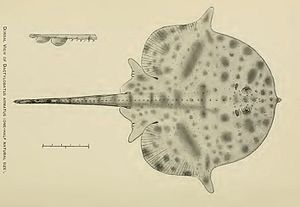Dactylobatus armatus
| Dactylobatus armatus | ||||||||||||
|---|---|---|---|---|---|---|---|---|---|---|---|---|

Dactylobatus armatus |
||||||||||||
| Systematics | ||||||||||||
|
||||||||||||
| Scientific name | ||||||||||||
| Dactylobatus armatus | ||||||||||||
| Bean & Weed , 1909 |
Dactylobatus armatus is a small deep-sea ray foundin the western central Atlantic .
Features and way of life
This ray is quite narrow and is colored gray on its back. On the belly it is yellowish to white with light shades of gray. The thorn-like projections on the front edge of its body are characteristic of this species. Female specimens usually reach a length of 32 centimeters, male individuals have never been spotted. It lives at depths of the sea from 338 to 685 meters. This species lays eggs that have small horn-like appendages on the edges. The embryos feed on the yolks contained in the eggs.
distribution
Dactylobatus armatus is native to the western central Atlantic, from South Carolina to South Florida as well as in the northern Gulf of Mexico and along the Caribbean coast from Nicaragua , Venezuela to southern Brazil .
Danger
The endangerment of this species can not be assessed due to the insufficient data basis . Research into the distribution, life cycles, populations and population developments of this species is required to enable future assessment. Bottom trawling bycatch poses a potential threat , although information is not available. There are currently no protective measures for Dactylobatus armatus , further data from deep-sea fishermen have to be collected.
supporting documents
- ↑ a b c Dactylobatus armatus on Fishbase.org (English)
- ↑ a b c Dactylobatus armatus in the Red List of Threatened Species of IUCN 2017-3. Posted by: Brash, JM & McEachran, JD, 2008-12-01.
Web links
- Dactylobatus armatus on Fishbase.org (English)